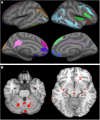The Neurocognitive and MRI Outcomes of West Nile Virus Infection: Preliminary Analysis Using an External Control Group
- PMID: 29636722
- PMCID: PMC5880927
- DOI: 10.3389/fneur.2018.00111
The Neurocognitive and MRI Outcomes of West Nile Virus Infection: Preliminary Analysis Using an External Control Group
Abstract
To understand the long-term neurological outcomes resultant of West Nile virus (WNV) infection, participants from a previously established, prospective WNV cohort were invited to take part in a comprehensive neurologic and neurocognitive examination. Those with an abnormal exam finding were invited for MRI to evaluate cortical thinning and regional brain atrophy following infection. Correlations of presenting clinical syndrome with neurologic and neurocognitive dysfunctions were evaluated, as well as correlations of neurocognitive outcomes with MRI results. From 2002 to 2012, a total of 262 participants with a history of WNV infection were enrolled as research participants in a longitudinal cohort study, and 117 completed comprehensive neurologic and neurocognitive evaluations. Abnormal neurological exam findings were identified in 49% (57/117) of participants, with most abnormalities being unilateral. The most common abnormalities included decreased strength (26%; 30/117), abnormal reflexes (14%; 16/117), and tremors (10%; 12/117). Weakness and decreased reflexes were consistent with lower motor neuron damage in a significant proportion of patients. We observed a 22% overall rate of impairment on the Repeatable Battery for the Assessment of Neuropsychological Status (RBANS), with impairments observed in immediate (31%) and delayed memory (25%). On MRI, participants showed significant cortical thinning as compared to age- and gender-matched controls in both hemispheres, with affected regions primarily occurring in the frontal and limbic cortices. Regional atrophy occurred in the cerebellum, brain stem, thalamus, putamen, and globus pallidus. This study provides valuable new information regarding the neurological outcomes following WNV infection, with MRI evidence of significant cortical thinning and regional atrophy; however, it is important to note that the results may include systemic bias due to the external control group. Considering no effective treatment measures are available, strategies to prevent infection are key.
Keywords: Repeatable Battery for the Assessment of Neuropsychological Status; West Nile virus; cortical thinning; neurocognitive outcomes; neurological outcomes; regional brain atrophy.
Figures



Similar articles
-
Does intra-individual neurocognitive variability relate to neuroinvasive disease and quality of life in West Nile Virus?J Neurovirol. 2018 Aug;24(4):506-513. doi: 10.1007/s13365-018-0641-5. Epub 2018 Apr 25. J Neurovirol. 2018. PMID: 29696579 Free PMC article.
-
Long-term neurological outcomes in West Nile virus-infected patients: an observational study.Am J Trop Med Hyg. 2015 May;92(5):1006-1012. doi: 10.4269/ajtmh.14-0616. Epub 2015 Mar 23. Am J Trop Med Hyg. 2015. PMID: 25802426 Free PMC article.
-
Long-term neuromuscular outcomes of west nile virus infection: A clinical and electromyographic evaluation of patients with a history of infection.Muscle Nerve. 2018 Jan;57(1):77-82. doi: 10.1002/mus.25660. Epub 2017 Jun 17. Muscle Nerve. 2018. PMID: 28380696
-
West Nile virus: should pediatricians care?J Infect. 2014 Nov;69 Suppl 1:S70-6. doi: 10.1016/j.jinf.2014.07.019. Epub 2014 Aug 17. J Infect. 2014. PMID: 25138381 Review.
-
Persistence of West Nile virus.Microbes Infect. 2015 Feb;17(2):163-8. doi: 10.1016/j.micinf.2014.12.003. Epub 2014 Dec 11. Microbes Infect. 2015. PMID: 25499188 Review.
Cited by
-
West Nile virus encephalitis: A report of two cases and review of neuroradiological features.Radiol Case Rep. 2020 Sep 23;15(11):2422-2426. doi: 10.1016/j.radcr.2020.09.023. eCollection 2020 Nov. Radiol Case Rep. 2020. PMID: 33005280 Free PMC article.
-
Cognitive decline following acute viral infections: literature review and projections for post-COVID-19.Eur Arch Psychiatry Clin Neurosci. 2022 Feb;272(1):139-154. doi: 10.1007/s00406-021-01286-4. Epub 2021 Jun 25. Eur Arch Psychiatry Clin Neurosci. 2022. PMID: 34173049 Free PMC article. Review.
-
Neurological and neuromuscular manifestations in patients with West Nile neuroinvasive disease, Belgrade area, Serbia, season 2022.Neurol Sci. 2024 Feb;45(2):719-726. doi: 10.1007/s10072-023-07025-y. Epub 2023 Aug 22. Neurol Sci. 2024. PMID: 37606743
-
Clinical Phenotyping of Long COVID Patients Evaluated in a Specialized Neuro-COVID Clinic.Ann Clin Transl Neurol. 2025 Jun;12(6):1126-1134. doi: 10.1002/acn3.70031. Epub 2025 Apr 8. Ann Clin Transl Neurol. 2025. PMID: 40200430 Free PMC article.
-
A Potential Role for Substance P in West Nile Virus Neuropathogenesis.Viruses. 2022 Sep 4;14(9):1961. doi: 10.3390/v14091961. Viruses. 2022. PMID: 36146768 Free PMC article.
References
Grants and funding
LinkOut - more resources
Full Text Sources
Other Literature Sources

